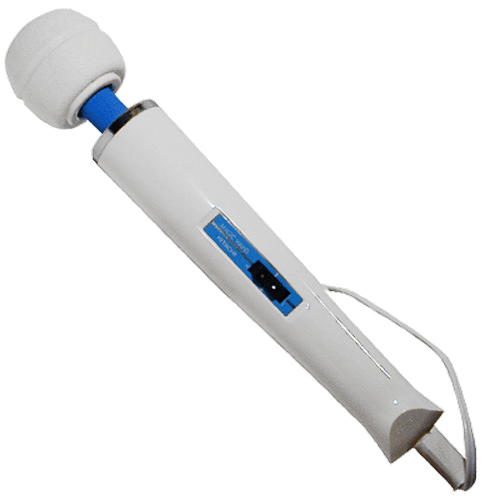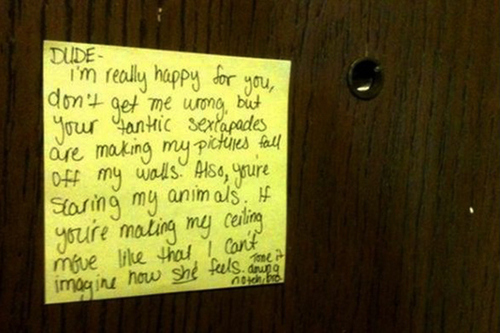Shhhhhhhh How to silence your vibrator
How to Silence Your Vibrator
It’s hard to get turned on when you’re self-conscious about someone overhearing that telltale bzzzzzz of your favorite vibe. Even when you’re alone or playing with a partner, the noise may be distracting. Many readers have asked us “How can I silence my noisy vibrator?” so we tried to find some homemade solutions to this common problem.

To find out, we took three commonly used vibrators and tested them using various materials to reduce their sound output. We were trying to find something that could be wrapped around a vibrator to dampen the noise – a vibrator “silencer”. We tried a lot of things – cardboard, styrofoam, polyurethane foam, bubble wrap, acoustic foam – but in the end we found that the muffling effect of a comforter or pillow was just as effective.

Big Noise in a Small Package
The trouble with using some kind of material to insulate your vibrator is that this approach will only work with certain kinds of toys, otherwise the insulation material will interfere with use. If you cover a vibrator completely, you’ll dampen the vibrations and make it less effective. If the toy is insertable, covering it will render it unusable. So if you’re using a bullet vibrator or a vibrating dildo, there’s not a whole lot you can do as far as sheathing it in sound-proof materials. With the vibrators we tested, it was possible to wrap most of the toy while still leaving a functional part exposed.

The three vibrators we used were the Hitachi Magic Wand, the iVibe, and an inexpensive slimline plastic vibrator. We used a digital noise meter to measure how many decibels the devices were putting out. While the Magic Wand is notoriously noisy, the iVibe, a finger-sized vibrator powered by a single AA battery, was louder by far. At close range (a few cm), the iVibe put out 92 dB, compared to 83 dB for the slimline vibrator and 73 dB for the Magic Wand (on the low speed setting). For reference, noise levels above 85 dB are considered harmful – so don’t hold your vibrator next to your ear. While the iVibe produces a very strong vibration relative to its size, its power comes with a price tag – it’s not cheap, and it’s very loud. This just goes to show that a smaller vibrator will not necessarily produce a smaller noise.
Acoustic Foam |
Bubble Wrap |
|
|
|
Cardboard |
Foam Rubber |
|
|
|
All Wrapped Up
Depending on the material used, encasing the vibrator in some sort of sound insulation decreased the noise output by 10-20 dB at close range. Cardboard was the least effective, and in fact generated noise by rattling in some cases. Bubble wrap, polyurethane foam, styrofoam, and acoustic foam were all pretty effective in reducing noise output at close range, taking the sound down an average of 20 dB. Further away than 2 feet, however, bubble wrap lost its edge while the others kept shaving 5-15 dBs off the sound. Some materials worked better for different devices. Acoustic foam worked well for the iVibe and the slimline, while polyurethane foam worked best for the Magic Wand. Polyurethane foam is the soft, usually yellow foam often used for seat cushions. It worked well enough for all of the vibrators, is soft, easy to work with, and not too difficult to find, so if you want to try shushing your vibrator with this method, this is the material we recommend.
Going Undercover
After playing around with different foams and padding and packaging materials, we decided to try a couple of things you’re likely to have right at hand when you use a vibrator: a pillow and a comforter. The pillow was about 8 inches thick and the comforter about 1 1/2 inches thick; both were filled with synthetic material. We tested the sound output of the vibrators while covering them. Both the pillow and comforter were as effective or more effective than any of the sound insulation materials we tried.
So if you’re using your vibrator in bed, probably the best thing you can do is pull the covers up or hold a pillow over your crotch while your vibrator’s in use. Interestingly, although the comforter was a lot less dense than the pillow, it was slightly more effective. Possibly this is because the pillow transmitted some of the sound waves, while allowing them to escape from the uncovered side. The comforter, on the other hand, was able to muffle the sound more completely if it surrounded it in such a way that the noise didn’t escape through an opening.
Can You Hear Me Now?
Loudness is relative to the proximity of the listener, so it’s important to know what you can hear from how far. Could you hear the vibrator from across the room? How about from a few feet away? Without any soundproofing, at 2 feet away, the range above ambient noise level in the room (42-47 dB) was 8-23 dB. At 5 feet, the range was 6-18 dB. At a distance of 10 feet, the Magic Wand and slimline vibrator did not register above the ambient noise level. At ten feet, the iVibe did raise the noise level by 8 dB, which is pretty loud (some neighborhoods ban leaf blowers that raise noise levels more than 10 dB).
All of the insulating materials we used neutralized the sound output from 5-10 feet away. However, the fact that a vibrator was not louder than the other noises in the room does not mean that it was inaudible. The hum that a vibrator makes will have a distinctive frequency that allows it to be picked out from other random sounds. This means that although you can quiet a vibrator down, it is difficult to actually “silence” it. To be on the safe side, you can try masking the sound, either with music or a white noise machine. (You can tell you roommate that you need the white noise to help you sleep.) That will make it harder to distinguish drone of the vibrator from other background sounds.
Tips for Choosing a Quieter Vibrator
Vibrators vary tremendously in the amount of noise they put out. The amount of noise depends a lot on the type of motor, but the material and design of the case also contribute. Hard plastic tends to be noisier because the motor and other parts will rattle around, and noise can resonate more inside a hollow plastic case. Vibrators that are made of or are covered in rubber may be quieter because the rubber absorbs some of the sound. In general, cheaper vibrators tend to be noisier, but there are exceptions.
If your vibrator is making an unusual noise, like whining, grinding, or rattling, something is probably broken inside and you may need to junk it. It may be possible to fix it if you take it apart. Sometimes the motor just needs a drop of oil. However, most vibrators aren’t built to be taken apart and reassembled, so try this at your own risk. If the sound is being caused by the batteries rattling in their compartment, this can usually be fixed easily with a small piece of cardboard.
When shopping for a new vibrator, do some research online and find out what users and retailers have to say about different models. Many sites feature user reviews that may be helpful. If you’re shopping in a brick-and-mortar store, don’t be shy about asking the salespeople questions – that’s what they’re there for, and they might let you test out some demo models before you make your purchase. Trying before you buy is the best way to avoid a noisemaker.
The original post was from homemade-sex-toys and comes with audio so you can hear the difference!











